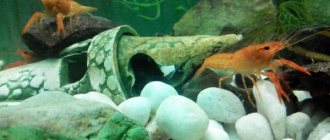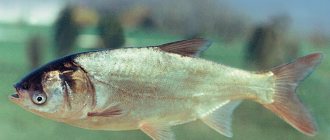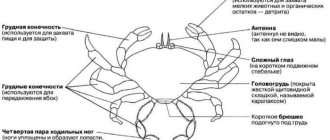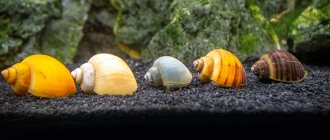Often when breeding crayfish, the question arises as to what crustaceans eat. Feeding crayfish is a responsible process that requires a serious approach. After all, their immunity, taste and further development depend on what arthropods eat. You cannot feed crayfish with any food. The article covers all the points related to feeding crayfish.
Features of feeding
As for feeding crayfish kept in an aquarium, swimming pool or specially created pond, it is important to know some rules and features:
- It is recommended to feed arthropods in the evening. Under natural conditions, individuals go in search of food when it gets dark.
- During the periods of reproduction and molting, crayfish eat in larger quantities, because their body begins to expend energy much faster.
- With improper or unbalanced nutrition, crayfish are prone to cannibalism, especially during the molting period. The place where crayfish are kept should be free and spacious, with several shelters.
- The daily diet of young crayfish is much higher than that of adults.
- Crayfish are able to leave their habitat in search of food. It is necessary to create conditions in which arthropods cannot escape.
- There are different diets for females and males. A rachikha (female) can consume food once every three days, while a crayfish requires food once every two days.
- After molting, you should not remove the remaining shell - later the cancer will eat it, because it is rich in a large amount of calcium, which contributes to the rapid recovery of the body.
Crayfish that eat properly and balanced grow intensively and are less likely to try to get out of their habitat.
Description
Freshwater crayfish, found in our reservoirs, has a hard chitinous shell (this dictates a dangerous lifestyle), which is an additional exoskeleton. The cancer body consists of a segmented abdomen and a cephalothorax, which, in turn, is divided into two parts - the head (anterior) and thoracic (posterior), fused together. There is a spike in the front of the head, near it there are eyes and antennae, which the animal needs as organs of smell and touch. Crayfish breathe through gills.
Crayfish jaws are modified limbs that are located on the sides of the mouth. They are followed by 5 pairs of thoracic limbs - claws and legs. Cancer uses the first for attack and defense. In turn, on the abdomen there are two-branched limbs that are necessary for swimming. The tail is the 7th abdominal segment.
Structure
Adult males are larger than females, and they also have much larger claws. If one of the limbs is lost, a new one grows after molting. Crayfish have an unsafe lifestyle and sometimes they lose their claws when competing with other crayfish, or they are simply bitten off by some other river predator; this happens rarely, but it does happen.
Types of feed
Crayfish are absolutely omnivorous creatures. They are fed both plant and meat foods. In nature, they spend most of their time in shallow waters in search of food, where they feed on a variety of mollusks, small fish, tadpoles, worms, and insects. Among plant foods, crayfish prefer water lilies, elodea, and pondweed. The total share of plant foods in the diet of arthropods is up to 90%.
Preparing feed yourself
Homemade food for crayfish should be similar to the food they are used to consuming in their natural environment. Replacement of animal food is bloodworms, pieces of squid, fish, shrimp or lean meat.
When preparing a diet for crayfish, crayfish should receive food of animal origin no more than twice a week. Many crayfish breeders claim that meat feed provokes the aggressive state of arthropods.
From plant foods, crayfish are fed the following products:
- zucchini;
- lettuce leaves;
- cucumbers;
- Chinese cabbage;
- spinach;
- carrots (contains keratin, which significantly enhances the color of crayfish);
- hornwort (the plant should be located in the habitat of crayfish).
When planting plants in an aquarium or a created pond, you must be extremely careful, because very often they are treated with insecticides, which can cause mass death of arthropods.
Industrially produced feed
Industrially produced food is available in granular form in various sizes, in the form of flakes or sticks.
Whichever option is preferred, the food must meet the following criteria:
- do not pollute the water in the pond;
- provide balanced nutrition;
- maintain the natural color of the shell;
- facilitate the process of changing the shell.
Specialized stores can offer types of food that are intended for special periods of life of crustaceans. For example, specialists often use feed designed to stimulate reproduction processes or strengthen the immune system of young animals.
Content
All about aquariums
- Types of aquariums: freshwater or saltwater aquarium
- Freshwater aquarium
- Starting a marine aquarium
- Which aquarium to choose
- Aquarium care
- Choosing soil for an aquarium
- Starting an aquarium
- Lighting and heating of the aquarium
- Aquarium care equipment
- Filtration and aeration
- DIY aquarium design
- Choosing a location for an aquarium
- Water for an aquarium and its main parameters
- How to make an aquarium yourself
- Modern marine aquarium
- How to repair an aquarium yourself
- Lighting for aquarium plants
- Aquarium heaters
- Fighting algae in the aquarium
All about aquarium plants
- Selection of aquarium plants
- Reproduction of aquarium plants
- Diseases of aquarium plants
- Aquarium plants maintenance and care
- Interesting facts about plants
- Algae in the aquarium
- Growing aquarium plants on rocks and driftwood
- Fertilizers for aquarium plants
All about aquarium fish
- Buying aquarium fish
- Keeping aquarium fish
- Structure of fish
- Types of aquarium fish, classification
- Breeding aquarium fish
- Feeding and food for aquarium fish
- Invertebrates in the aquarium
- Interesting facts about fish
- Aquarium snails
- Feeding aquarium fish
All about aquarium fish diseases
- Diseases of aquarium fish
- Prevention of fish diseases
- Stress in fish
- Aquarium disinfectants
- Anesthetic agents for aquarium fish
- Healthy fish or sick fish
- Treatment of aquarium fish
Question - answer (problems in the aquarium)
- What to do if the aquarium is leaking
- What to do if the aquarium breaks
- What to do if the water heating system in the aquarium fails
- What to do if the filter in the aquarium is broken
- What to do if the aeration system in the aquarium fails
- What to do if there is no power supply to the aquarium
- What to do if the water in the aquarium is cloudy or has an uncharacteristic color
- What to do if a film forms on the surface of the water in the aquarium
- What to do if you have to leave the aquarium unattended while you are on vacation
- What to do if renovations begin in the room where the aquarium is located
Question - answer (fish diseases)
- What to do if the fish “coughs”
- What to do if your fish is vomiting
- What to do if the fish “yawns”
- What to do if the fish is blind. Cloudiness of the cornea of the eye
- What to do if the fish doesn't eat
- What to do if your fish has bulging eyes
- What to do if the fish is staring intently at one point
- What to do if the fish can't close its mouth
- What to do if “worms” or other animals are attached to the fish
- What to do if spots appear on the fish
- What to do if your fish has tumors
- What to do if the fish is too thin
- What to do if your fish has growth retardation
- What to do if the fish has changed color
- What to do if the fish has holes
- What to do if a substance resembling cotton wool appears on the fish
- What to do if the fish is covered with viscous mucus
- What to do if there are bubbles on the fish or its excrement
- What to do if the fish has a distorted body shape
- What to do if the fish is swollen
- What to do if a fish has lost part of its scales
- What to do if a fish hits the glass
- What to do if the fish is less active than usual
- What to do if the fish is always at the surface of the water
- What to do if the fish is swimming at an unusual angle
- What to do if the fish is lying on the bottom
- What to do if the fish is constantly rushing around the aquarium
- What to do if your fish itches all the time
- What to do if the fish is choking
- What to do if the fish is hiding
- What to do if your fish has seizures
- What to do if the fish wants to jump out of the aquarium
- What to do if fry do not emerge from eggs laid by fish
- What to do if your fish has abnormal excrement
- What to do if the fish’s fins are frayed and frayed
- What to do if a fish squeezes its fins
- What to do if the fish is breathing faster than usual
- What to do if your fish's gills look abnormal
- What to do if a fish jumps out of the aquarium
No sorting
- Aquarium ABC
- Tips for beginner aquarists
- All about aquarium soil
- Launch of a new aquarium
- All about water in the aquarium
- Apple snails (ampularia)
- Keeping and breeding apple apples
- Questions and answers about ampoules
- Dutch aquarium, large size decorative aquarium
- Glow in the dark aquarium soil
- Proper preparation of peat decoction for an aquarium
- Keeping Achatina snails at home
- What to feed aquarium crayfish
Crayfish farming business plan. home farm, or how to breed crayfish at home
Feeding the young
Young animals are fed differently than adult crayfish. Young individuals are fed with small daphnia, food for fish fry, vinegar nematode, crushed tubifex, and brine shrimp.
When feeding small daphnia to crayfish, it is first recommended to scald it with boiling water, because when alive it is very mobile, which will make it difficult for small crayfish to catch it.
Young crayfish need more food than adults. For these reasons, they search for food day and night. They feed on detritus - a product of the natural decay of various organic matter. For example, in an aquarium whose water is constantly filtered, there is very little detritus.
To replace it, fallen leaves of trees are often used. It is better to give preference to dry leaves of oak, alder and beech - they will be an excellent source of valuable food, which not only promotes the development of their digestive system, but will also help get rid of parasites. Crayfish eat leaves in an aquarium very quickly; they need to be added regularly.
It is prohibited to use freshly picked leaves to add to the aquarium - they have the ability to release toxins into the water.
Feeders
You should not throw food for the inhabitants of an aquarium or pond directly into the water. It's better to buy a feeder. The store offers a wide range of products that differ in size and shape. The main factor determining the choice is the absence of toxic substances in the composition of the material.
The design of the feeder consists of a fixed platform on which the feed is placed, and fences. It can be made accessible to everyone using available means and materials. A sheet of wood or non-toxic plastic is taken as a basis, and the sides are fixed at the edges. That's it, the feeder is ready!
Feeding adult crayfish
Adults prefer minced meat from warm-blooded animals and fish, frogs and tadpoles. Before the molting period, it is advisable to feed crustaceans with crushed small mollusks, strongly crushing the bivalve shells.
They use kitchen waste for feeding, giving the arthropods meat trimmings, vegetable peels, bread scraps, etc. If the waste is not completely fresh, it is pre-boiled.
Heavily decomposed food should not be used for feeding, as this can cause a massive disease of crayfish.
Boiled grains, especially round ones (corn, peas), need to be mashed before giving to the crayfish, otherwise it will be difficult for him to grab them with his claws. The food is laid out in the dark in small places. They give food in such a way that it is completely eaten. It is important to establish control over the consumption of food by running a net along the bottom. Crayfish in reservoirs are fed sparingly, especially if they are fed animal food.
If there is leftover food, the owner needs to reduce the amount or not feed the crayfish at all for some time. When food remains rot, the water becomes polluted, causing arthropods to suffer from various diseases that lead to their death.
Feeding begins in April with a diet of 0.5% of the live weight of the crayfish, increasing in warm times after molting and during the period of intensive growth, so that the amount of food is 2-2.5% of the live weight. During the molting period, they stop feeding the crayfish for several days. When it gets cold, arthropods are not fed or food continues to be given in dense plantings at reduced rates. In winter, feeding crayfish should be careful: during this period the nutritional requirement is small, but they need to be fed periodically.
A properly formulated diet will ensure good health for arthropods. It is important to take a responsible approach to feeding crayfish. It is unacceptable to use the first available products or feed of questionable quality to feed crayfish.
Diet during molting period
Molting is common for crayfish. Crustaceans grow throughout their entire life; due to the chitinous cover, this is not possible, because it is hard. Cancer needs it to be reset regularly. During molting, arthropods lose their activity and spend most of their time in shelter. If, instead of cancer, only its shell was seen, do not be alarmed, this is a natural process.
The chitinous cover is not removed - the cancer will eat it. After molting, young crayfish require a lot of calcium, which contributes to the rapid restoration of a new coating. In the first stages of their life, arthropods molt 5-6 times. After a few years, molting occurs several times throughout the year. The process itself lasts only 2-3 minutes. The new cover is completely restored in 1-1.5 weeks.
Before molting, it is necessary to increase the volume or frequency of feeding by approximately 4 times. It is allowed to feed crayfish with specialized food.
It is recommended to feed the following foods:
- pasta;
- shrimps;
- carrot;
- fish;
- porridge;
- worms;
- snails;
- meat;
- bloodworm;
- tubifex;
- coretra;
- Daphnia;
- gammarus.
Arthropods will also like a diet consisting of cabbage, lettuce, peas, parsley, zucchini, nettles, spinach, frozen vegetables, tree leaves, and even dry food for aquarium fish.
Hazardous properties
Crayfish meat is a fairly allergenic product, and therefore it is recommended to use it with great caution, especially for people prone to allergies [10]. Also, people who have problems with the thyroid gland should not abuse crustaceans. Although, it would seem, crayfish meat is so rich in iodine that this should, on the contrary, have a positive effect on the course of the disease. But doctors especially emphasize the fact that crayfish meat rich in iodine can only be used for disease prevention [11]. It is not used to treat the disease.
Improperly prepared crayfish can become a source of gastrointestinal problems and dangerous poisoning for humans [12]. It must be remembered that only fresh product is suitable for cooking in order to avoid undesirable consequences. It is necessary to observe not only the correct cooking process, but also the storage of crayfish meat. It is better to store the product in glass containers, since the sulfur in its composition does not allow the use of metal products for this. Upon contact with it, the meat of crustaceans turns black and quickly deteriorates.
How to feed crayfish when catching them?
Bait for catching crayfish is selected based on the season of the year. Vegetable complementary foods are effective in spring and summer. In autumn and early winter, animal food is used to feed arthropods. For this use:
- meat trimmings;
- fish;
- entrails of fish and poultry;
- shellfish;
- worms;
- snails;
- frogs;
- meat.
The fish is served fresh or slightly spoiled. To enhance the smell, it is dried a little in the sun. Cancers like roach, crucian carp and bream. For meat products, it is advisable to use poultry or meat carcass. It is also served stale. Clams, snails and frogs are caught in the same body of water where they are going to catch crayfish. Worms are used extremely rarely in the absence of other options: they are placed in a piece of thin gauze, preventing them from spreading.
Of the vegetable baits, it is most effective to use corn, dill, peas, black bread, macadamia, and garlic. Peas and corn are boiled, steamed or purchased canned. Crustaceans are attracted to the garlic aroma, which is why it is recommended to add it to other products.
When choosing bait, take into account the time of year:
| Season | What to feed? |
| Summer | They are fed with a piece of liver, meat, and chicken giblets. To enhance the smell, fish oil is added. |
| Spring | They use vegetable bait or fish, which are first cut along the ridge, turned inside out and left in the sun to spoil. |
| Winter and autumn | It is recommended to use rancid meat or peas. |
The habitat is also very important. For hunting in reservoirs with muddy bottoms, it is advisable to use bait made from spoiled fish. It is a common food for crayfish that live in such conditions. Arthropods will crawl into the “trap” without suspecting anything. If there is a lot of vegetation at the bottom, using peas or corn is more effective.
For fishing in underwater caves or under the shore, bait with a strong smell of garlic or spoiled meat is used. In shallow water, experts advise using worms, shellfish, and corn for bait.
What kind of animal is that?
Before we talk about what crayfish eat, it’s worth getting to know these arthropod inhabitants of the water element. These animals belong to invertebrate crustaceans. There are many types, to name just a few of the most common:
- European;
- Far Eastern;
- Cuban;
- Florida;
- marble;
- Mexican dwarf, etc.
Crayfish are widespread across all continents. Their habitat is freshwater rivers, lakes, ponds and other bodies of water. Moreover, several species can live in one place at once.
Externally, cancer looks quite interesting. It has two sections: the cephalothorax and abdomen. On the head there are two pairs of antennae and compound eyes. And the chest has eight pairs of limbs, two of which are claws. In nature, you can find crayfish of a wide variety of colors, from brown and green to bluish-blue and red. During cooking, all pigments disintegrate, leaving only red.
It’s not for nothing that crayfish meat is considered a delicacy. In addition to its excellent taste, it contains virtually no fat, and therefore has low calorie content. In addition, meat contains many useful substances. There is calcium, iodine, vitamin E, and almost all B vitamins.
This is interesting: Rainbow or sunny perch - description, fishing, photo, is it possible to eat
What does cancer eat in its natural environment?
Cancers have an excellent sense of smell. Under natural conditions, they are able to find rotten fish faster than fresh fish, because it has a distinct odor as it decomposes. In rivers, fighting crayfish are more common, fighting over an old fish carcass.
Their vision is no less well developed. Seeing something red, crayfish will definitely want to try it, considering the object a piece of meat.
Crayfish tend to eat algae rich in lime. They need it for healthy shell growth; they especially need lime during the molting period when shedding the old “armor” and growing a new one.
Crayfish need the following algae:
- elodea;
- Characeae plant species;
- hornwort.
Only crayfish feed on these plants, because they contain lime, which gives the arthropods rigidity, which they do not disdain. This is important to take into account when feeding crayfish at home - it is advisable to increase the amount of lime in the crayfish food.
In addition to plants, they feed on a variety of aquatic life, various types of invertebrates, for example, daphnia or cyclops. They also feed on larvae, tadpoles, snails, and worms.
It is recommended to breed phyto- and zooplankton in the reservoir. Crayfish have a positive attitude towards such a neighborhood. These species serve as food not only for crayfish, but also for their prey.
Feeding crayfish is a responsible task, because the weight of the arthropod and further profit from their sale depend on proper nutrition and diet planning. If you follow the feeding rules, you will be able to speed up the process of growth and reproduction and keep active crayfish.
0
0
Copy link
Adviсe
- In summer, the amount of food needed increases.
- In winter, when kept outdoors, there is no need to feed crayfish until spring.
- Their growth and reproduction rate depend on what they feed crayfish.
- Crayfish do not like turbidity in a pond.
- A properly prepared living area will reduce feed costs.
- For the growth of juveniles and reproduction, a comfortable temperature of about 15 degrees.
- Crayfish are inhabitants of clean bodies of water; their behavior makes it immediately obvious if something is wrong with the water.










